An Analysis of IoT Wearable Devices in the Healthcare Sector
VerifiedAdded on 2020/03/13
|9
|1253
|35
Report
AI Summary
This report provides an overview of the Internet of Things (IoT) and its application in wearable devices within the healthcare industry. It addresses challenges faced by patients and healthcare providers, highlighting how IoT solutions, such as smartwatches and health bands, can improve patient care and monitoring. The report details the features and working mechanisms of these devices, including data storage in the cloud and connectivity with smartphones. It also presents a diagram illustrating the system's architecture and discusses the advantages, such as cost reduction, accessibility, and security, alongside limitations like high initial costs and potential skin irritation. The conclusion emphasizes the role of IoT in managing health problems and the availability of various wearable devices for healthcare solutions. The report also includes references to supporting literature.
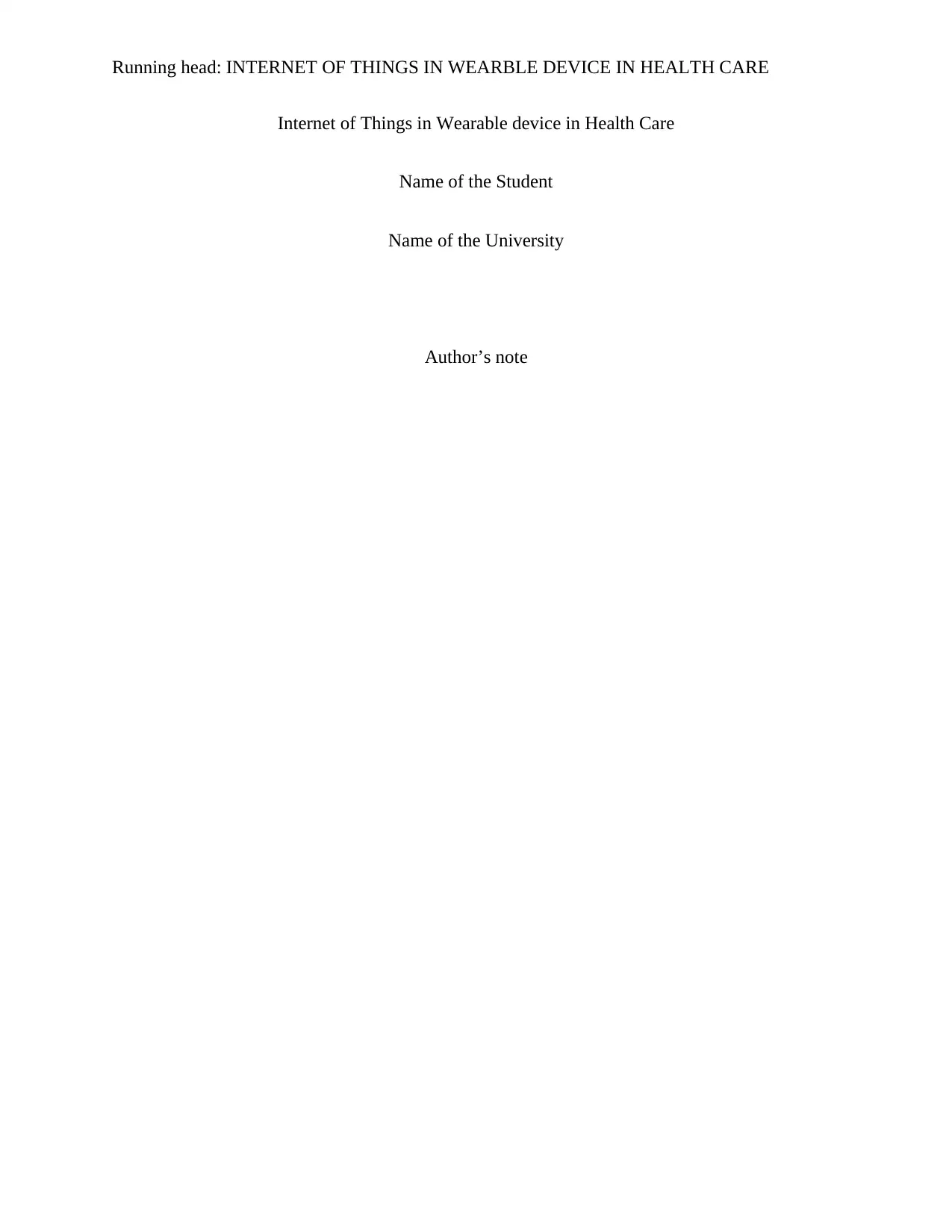
Running head: INTERNET OF THINGS IN WEARBLE DEVICE IN HEALTH CARE
Internet of Things in Wearable device in Health Care
Name of the Student
Name of the University
Author’s note
Internet of Things in Wearable device in Health Care
Name of the Student
Name of the University
Author’s note
Paraphrase This Document
Need a fresh take? Get an instant paraphrase of this document with our AI Paraphraser
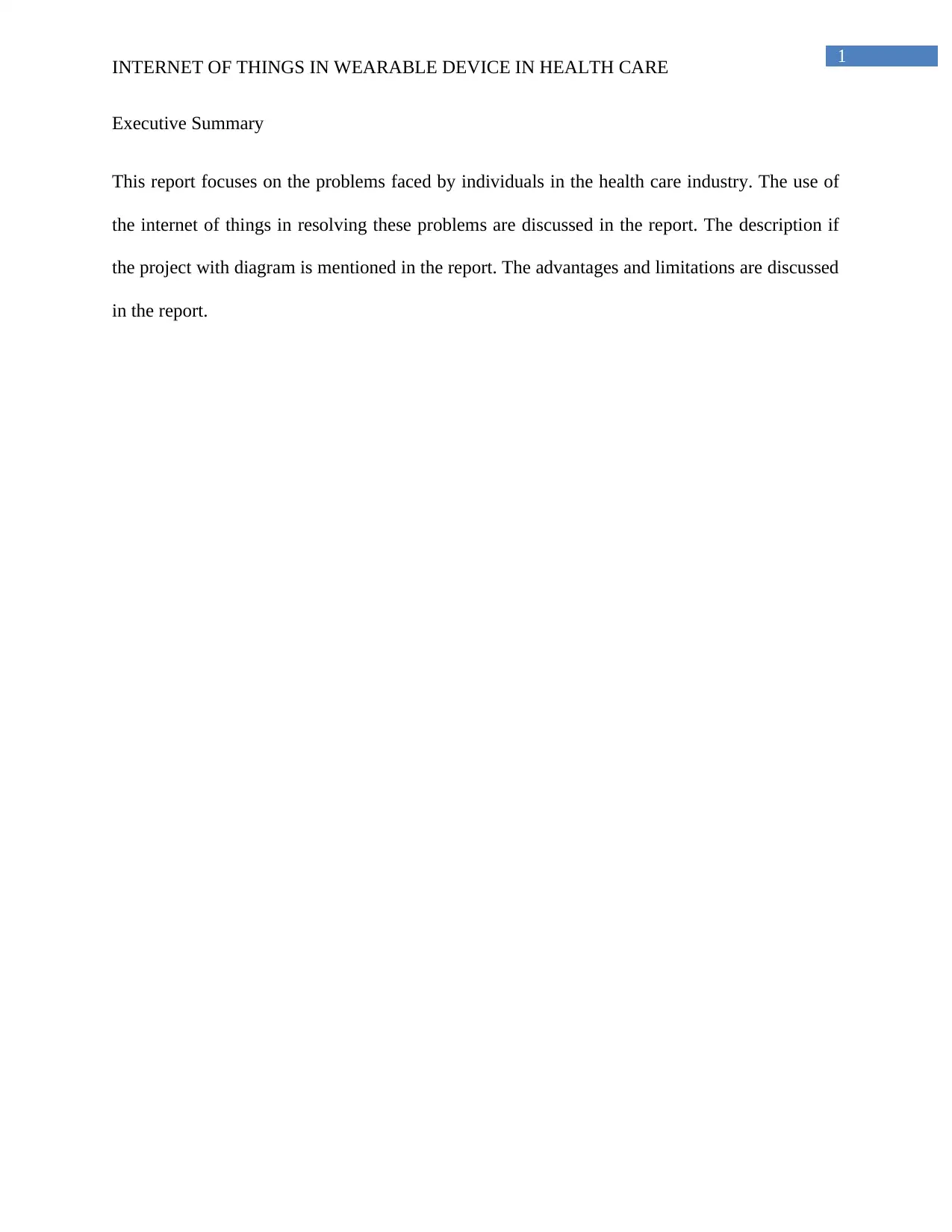
1
INTERNET OF THINGS IN WEARABLE DEVICE IN HEALTH CARE
Executive Summary
This report focuses on the problems faced by individuals in the health care industry. The use of
the internet of things in resolving these problems are discussed in the report. The description if
the project with diagram is mentioned in the report. The advantages and limitations are discussed
in the report.
INTERNET OF THINGS IN WEARABLE DEVICE IN HEALTH CARE
Executive Summary
This report focuses on the problems faced by individuals in the health care industry. The use of
the internet of things in resolving these problems are discussed in the report. The description if
the project with diagram is mentioned in the report. The advantages and limitations are discussed
in the report.
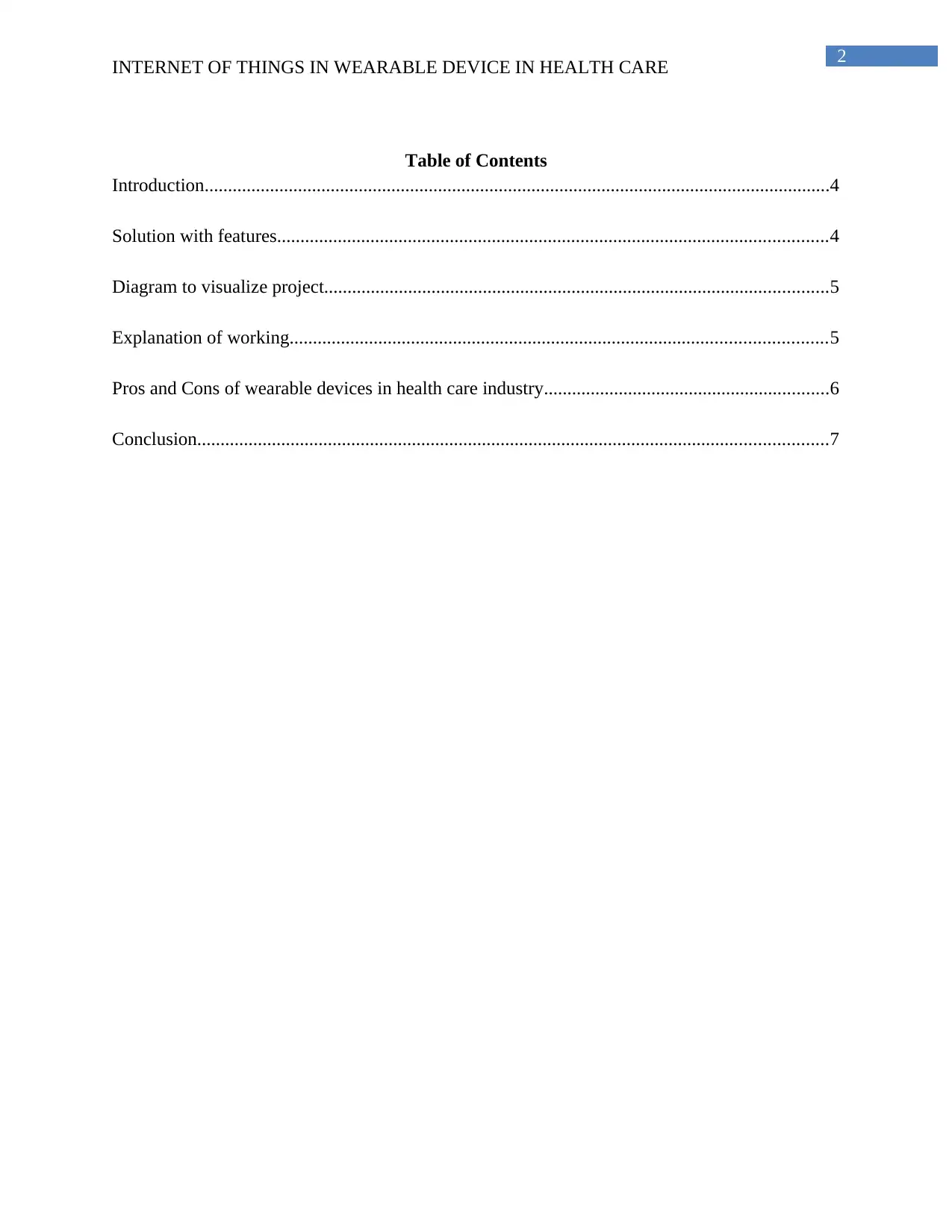
2
INTERNET OF THINGS IN WEARABLE DEVICE IN HEALTH CARE
Table of Contents
Introduction......................................................................................................................................4
Solution with features......................................................................................................................4
Diagram to visualize project............................................................................................................5
Explanation of working...................................................................................................................5
Pros and Cons of wearable devices in health care industry.............................................................6
Conclusion.......................................................................................................................................7
INTERNET OF THINGS IN WEARABLE DEVICE IN HEALTH CARE
Table of Contents
Introduction......................................................................................................................................4
Solution with features......................................................................................................................4
Diagram to visualize project............................................................................................................5
Explanation of working...................................................................................................................5
Pros and Cons of wearable devices in health care industry.............................................................6
Conclusion.......................................................................................................................................7
⊘ This is a preview!⊘
Do you want full access?
Subscribe today to unlock all pages.

Trusted by 1+ million students worldwide
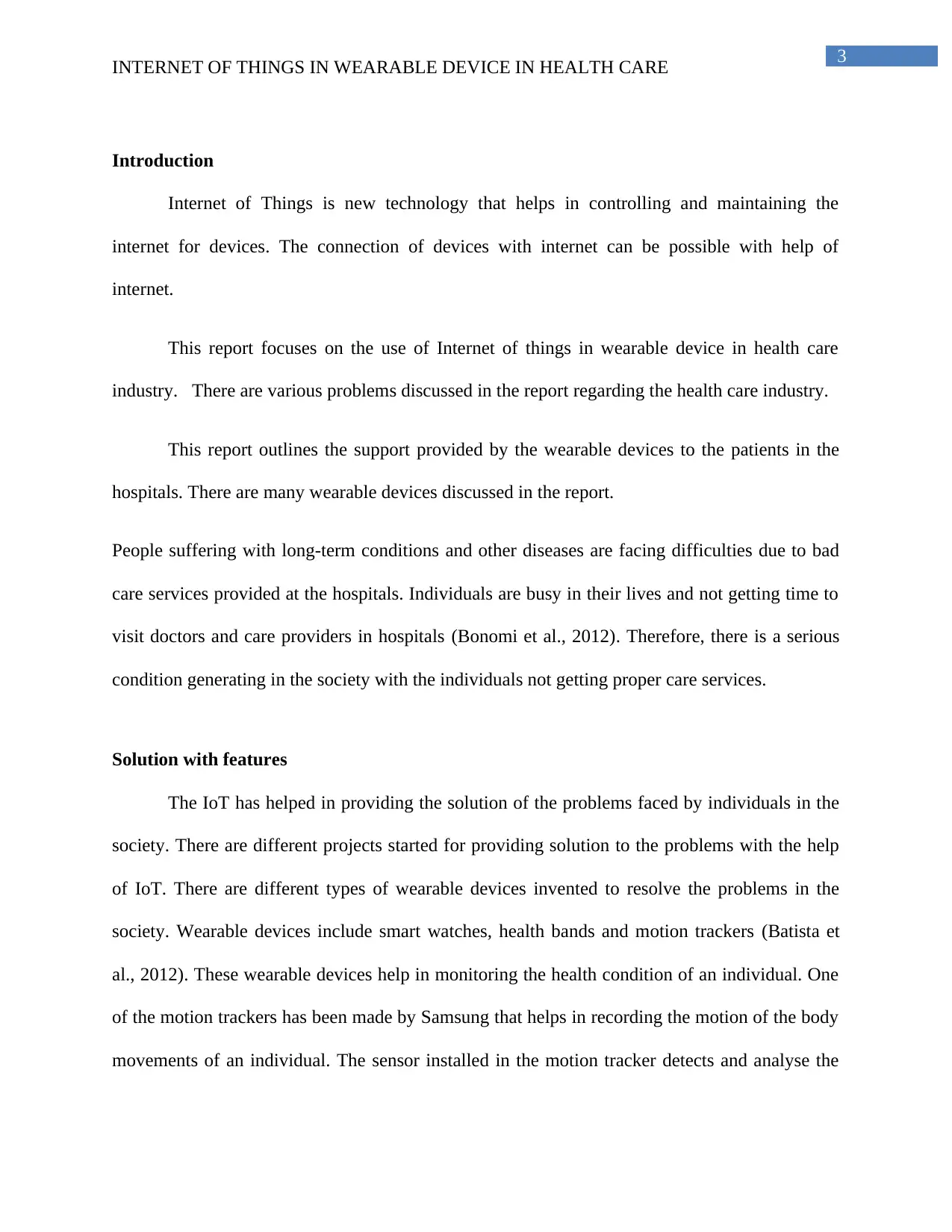
3
INTERNET OF THINGS IN WEARABLE DEVICE IN HEALTH CARE
Introduction
Internet of Things is new technology that helps in controlling and maintaining the
internet for devices. The connection of devices with internet can be possible with help of
internet.
This report focuses on the use of Internet of things in wearable device in health care
industry. There are various problems discussed in the report regarding the health care industry.
This report outlines the support provided by the wearable devices to the patients in the
hospitals. There are many wearable devices discussed in the report.
People suffering with long-term conditions and other diseases are facing difficulties due to bad
care services provided at the hospitals. Individuals are busy in their lives and not getting time to
visit doctors and care providers in hospitals (Bonomi et al., 2012). Therefore, there is a serious
condition generating in the society with the individuals not getting proper care services.
Solution with features
The IoT has helped in providing the solution of the problems faced by individuals in the
society. There are different projects started for providing solution to the problems with the help
of IoT. There are different types of wearable devices invented to resolve the problems in the
society. Wearable devices include smart watches, health bands and motion trackers (Batista et
al., 2012). These wearable devices help in monitoring the health condition of an individual. One
of the motion trackers has been made by Samsung that helps in recording the motion of the body
movements of an individual. The sensor installed in the motion tracker detects and analyse the
INTERNET OF THINGS IN WEARABLE DEVICE IN HEALTH CARE
Introduction
Internet of Things is new technology that helps in controlling and maintaining the
internet for devices. The connection of devices with internet can be possible with help of
internet.
This report focuses on the use of Internet of things in wearable device in health care
industry. There are various problems discussed in the report regarding the health care industry.
This report outlines the support provided by the wearable devices to the patients in the
hospitals. There are many wearable devices discussed in the report.
People suffering with long-term conditions and other diseases are facing difficulties due to bad
care services provided at the hospitals. Individuals are busy in their lives and not getting time to
visit doctors and care providers in hospitals (Bonomi et al., 2012). Therefore, there is a serious
condition generating in the society with the individuals not getting proper care services.
Solution with features
The IoT has helped in providing the solution of the problems faced by individuals in the
society. There are different projects started for providing solution to the problems with the help
of IoT. There are different types of wearable devices invented to resolve the problems in the
society. Wearable devices include smart watches, health bands and motion trackers (Batista et
al., 2012). These wearable devices help in monitoring the health condition of an individual. One
of the motion trackers has been made by Samsung that helps in recording the motion of the body
movements of an individual. The sensor installed in the motion tracker detects and analyse the
Paraphrase This Document
Need a fresh take? Get an instant paraphrase of this document with our AI Paraphraser
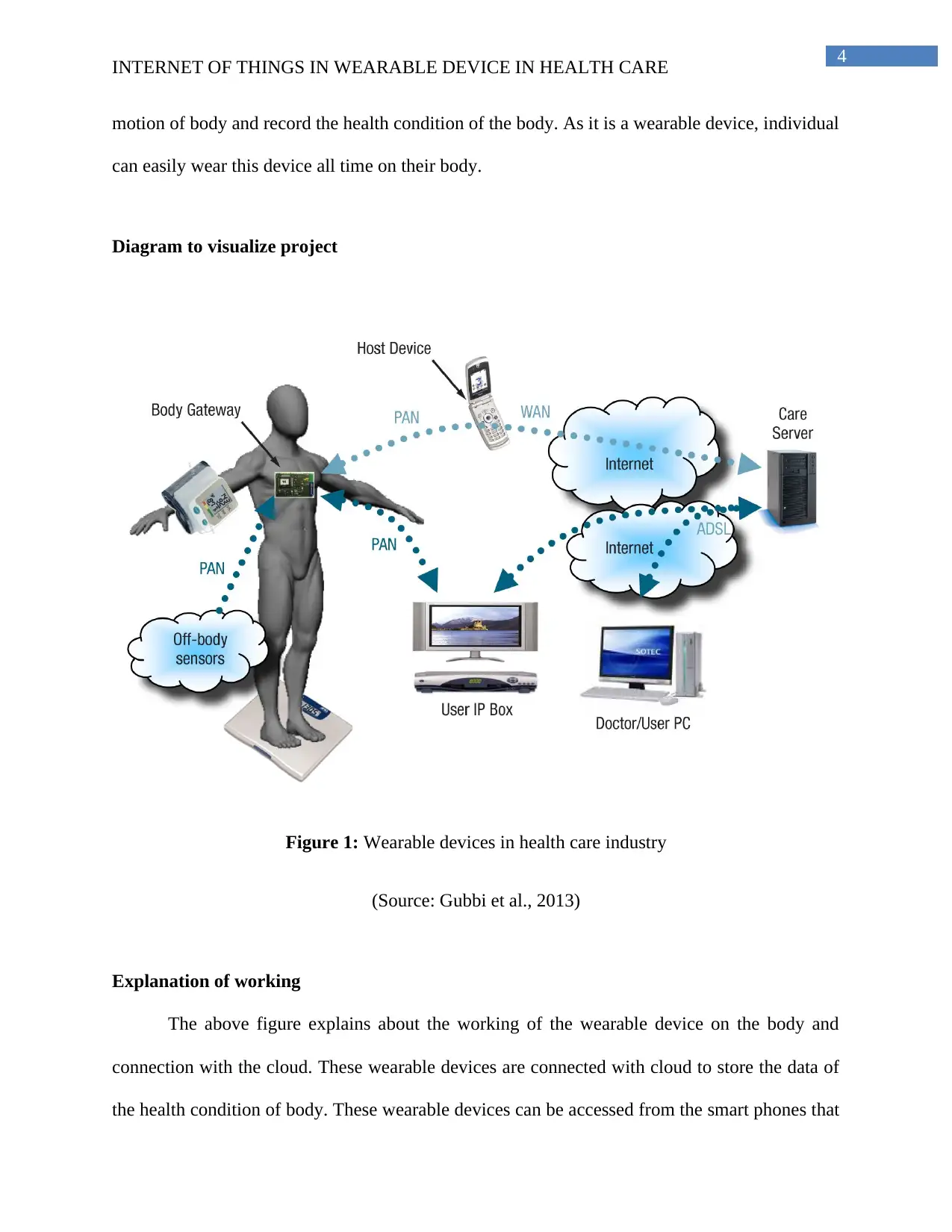
4
INTERNET OF THINGS IN WEARABLE DEVICE IN HEALTH CARE
motion of body and record the health condition of the body. As it is a wearable device, individual
can easily wear this device all time on their body.
Diagram to visualize project
Figure 1: Wearable devices in health care industry
(Source: Gubbi et al., 2013)
Explanation of working
The above figure explains about the working of the wearable device on the body and
connection with the cloud. These wearable devices are connected with cloud to store the data of
the health condition of body. These wearable devices can be accessed from the smart phones that
INTERNET OF THINGS IN WEARABLE DEVICE IN HEALTH CARE
motion of body and record the health condition of the body. As it is a wearable device, individual
can easily wear this device all time on their body.
Diagram to visualize project
Figure 1: Wearable devices in health care industry
(Source: Gubbi et al., 2013)
Explanation of working
The above figure explains about the working of the wearable device on the body and
connection with the cloud. These wearable devices are connected with cloud to store the data of
the health condition of body. These wearable devices can be accessed from the smart phones that
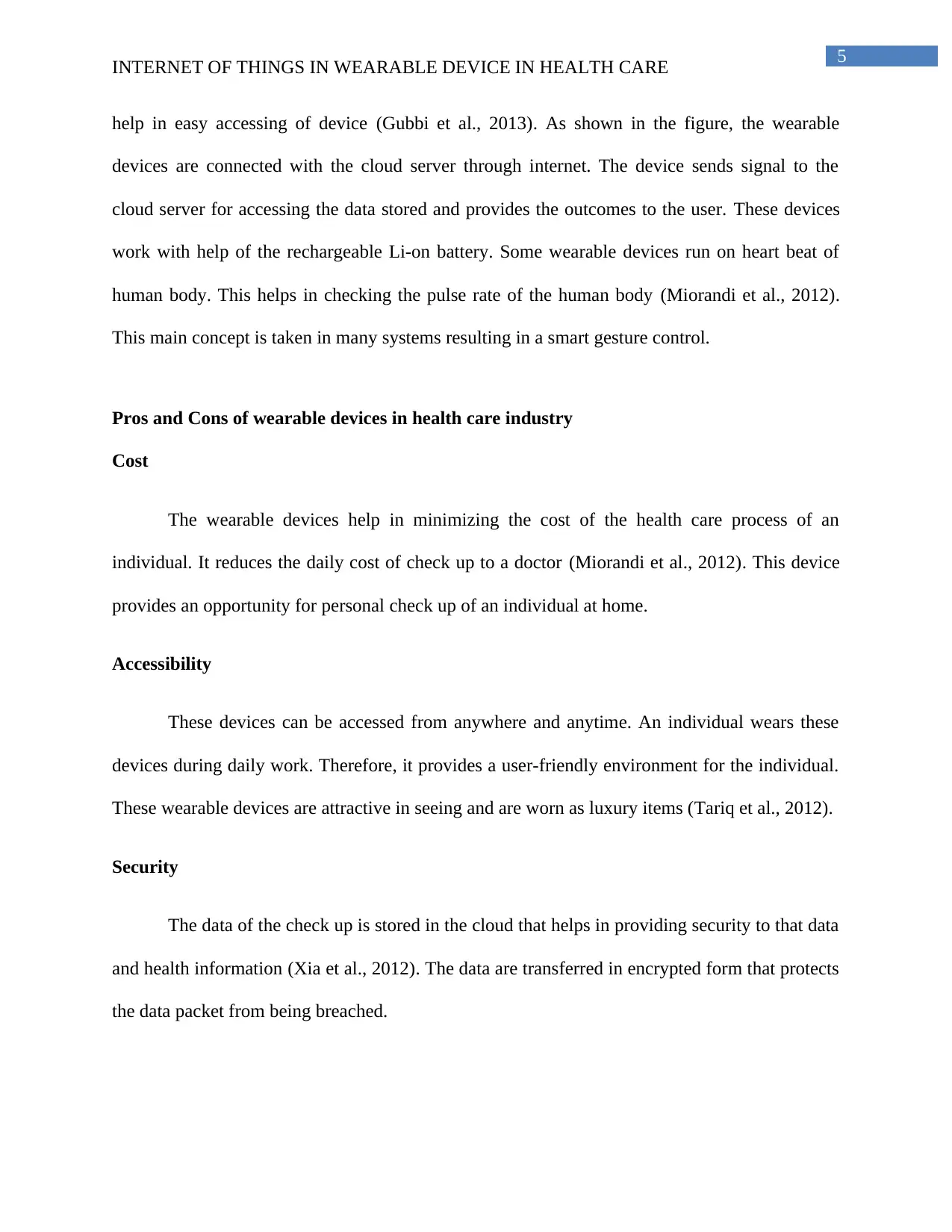
5
INTERNET OF THINGS IN WEARABLE DEVICE IN HEALTH CARE
help in easy accessing of device (Gubbi et al., 2013). As shown in the figure, the wearable
devices are connected with the cloud server through internet. The device sends signal to the
cloud server for accessing the data stored and provides the outcomes to the user. These devices
work with help of the rechargeable Li-on battery. Some wearable devices run on heart beat of
human body. This helps in checking the pulse rate of the human body (Miorandi et al., 2012).
This main concept is taken in many systems resulting in a smart gesture control.
Pros and Cons of wearable devices in health care industry
Cost
The wearable devices help in minimizing the cost of the health care process of an
individual. It reduces the daily cost of check up to a doctor (Miorandi et al., 2012). This device
provides an opportunity for personal check up of an individual at home.
Accessibility
These devices can be accessed from anywhere and anytime. An individual wears these
devices during daily work. Therefore, it provides a user-friendly environment for the individual.
These wearable devices are attractive in seeing and are worn as luxury items (Tariq et al., 2012).
Security
The data of the check up is stored in the cloud that helps in providing security to that data
and health information (Xia et al., 2012). The data are transferred in encrypted form that protects
the data packet from being breached.
INTERNET OF THINGS IN WEARABLE DEVICE IN HEALTH CARE
help in easy accessing of device (Gubbi et al., 2013). As shown in the figure, the wearable
devices are connected with the cloud server through internet. The device sends signal to the
cloud server for accessing the data stored and provides the outcomes to the user. These devices
work with help of the rechargeable Li-on battery. Some wearable devices run on heart beat of
human body. This helps in checking the pulse rate of the human body (Miorandi et al., 2012).
This main concept is taken in many systems resulting in a smart gesture control.
Pros and Cons of wearable devices in health care industry
Cost
The wearable devices help in minimizing the cost of the health care process of an
individual. It reduces the daily cost of check up to a doctor (Miorandi et al., 2012). This device
provides an opportunity for personal check up of an individual at home.
Accessibility
These devices can be accessed from anywhere and anytime. An individual wears these
devices during daily work. Therefore, it provides a user-friendly environment for the individual.
These wearable devices are attractive in seeing and are worn as luxury items (Tariq et al., 2012).
Security
The data of the check up is stored in the cloud that helps in providing security to that data
and health information (Xia et al., 2012). The data are transferred in encrypted form that protects
the data packet from being breached.
⊘ This is a preview!⊘
Do you want full access?
Subscribe today to unlock all pages.

Trusted by 1+ million students worldwide
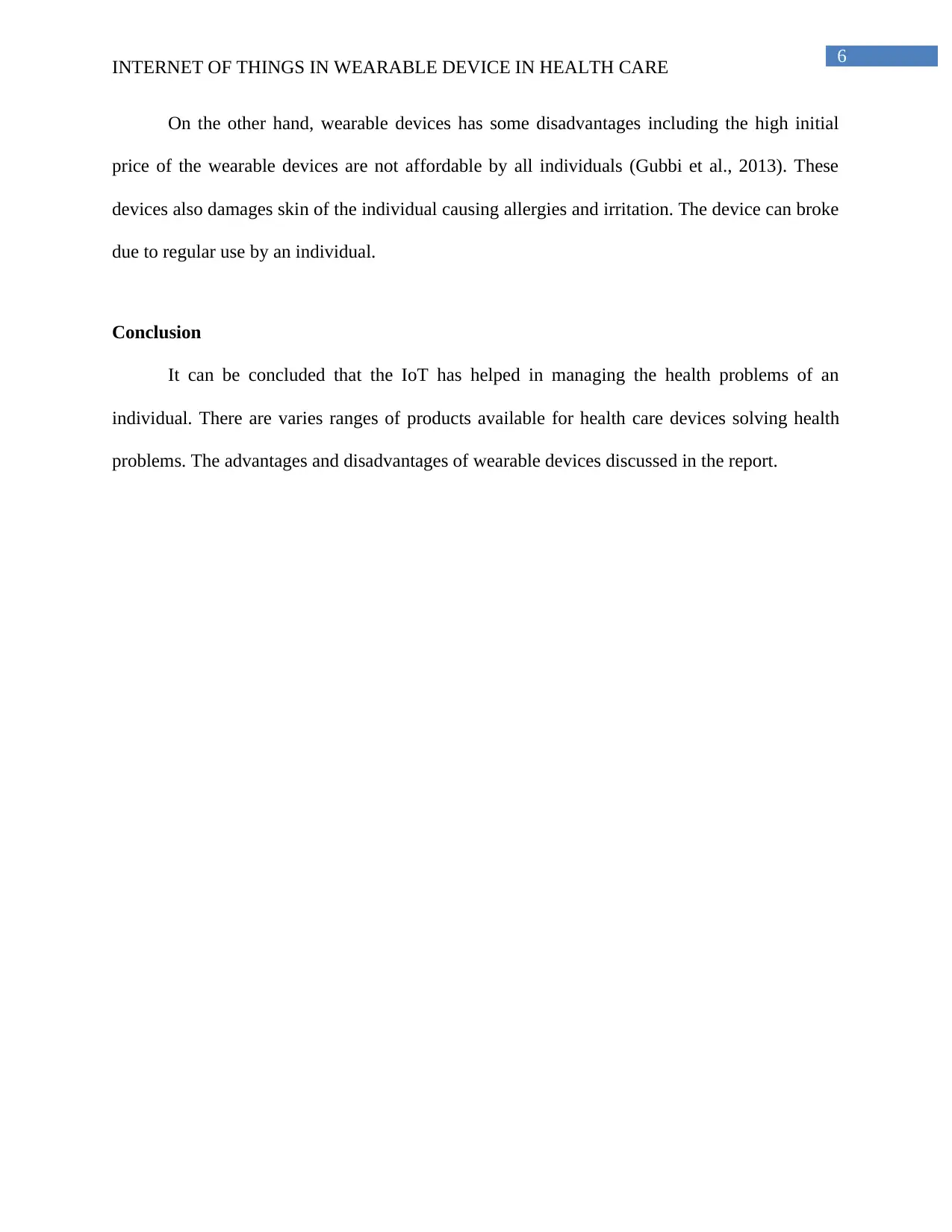
6
INTERNET OF THINGS IN WEARABLE DEVICE IN HEALTH CARE
On the other hand, wearable devices has some disadvantages including the high initial
price of the wearable devices are not affordable by all individuals (Gubbi et al., 2013). These
devices also damages skin of the individual causing allergies and irritation. The device can broke
due to regular use by an individual.
Conclusion
It can be concluded that the IoT has helped in managing the health problems of an
individual. There are varies ranges of products available for health care devices solving health
problems. The advantages and disadvantages of wearable devices discussed in the report.
INTERNET OF THINGS IN WEARABLE DEVICE IN HEALTH CARE
On the other hand, wearable devices has some disadvantages including the high initial
price of the wearable devices are not affordable by all individuals (Gubbi et al., 2013). These
devices also damages skin of the individual causing allergies and irritation. The device can broke
due to regular use by an individual.
Conclusion
It can be concluded that the IoT has helped in managing the health problems of an
individual. There are varies ranges of products available for health care devices solving health
problems. The advantages and disadvantages of wearable devices discussed in the report.
Paraphrase This Document
Need a fresh take? Get an instant paraphrase of this document with our AI Paraphraser
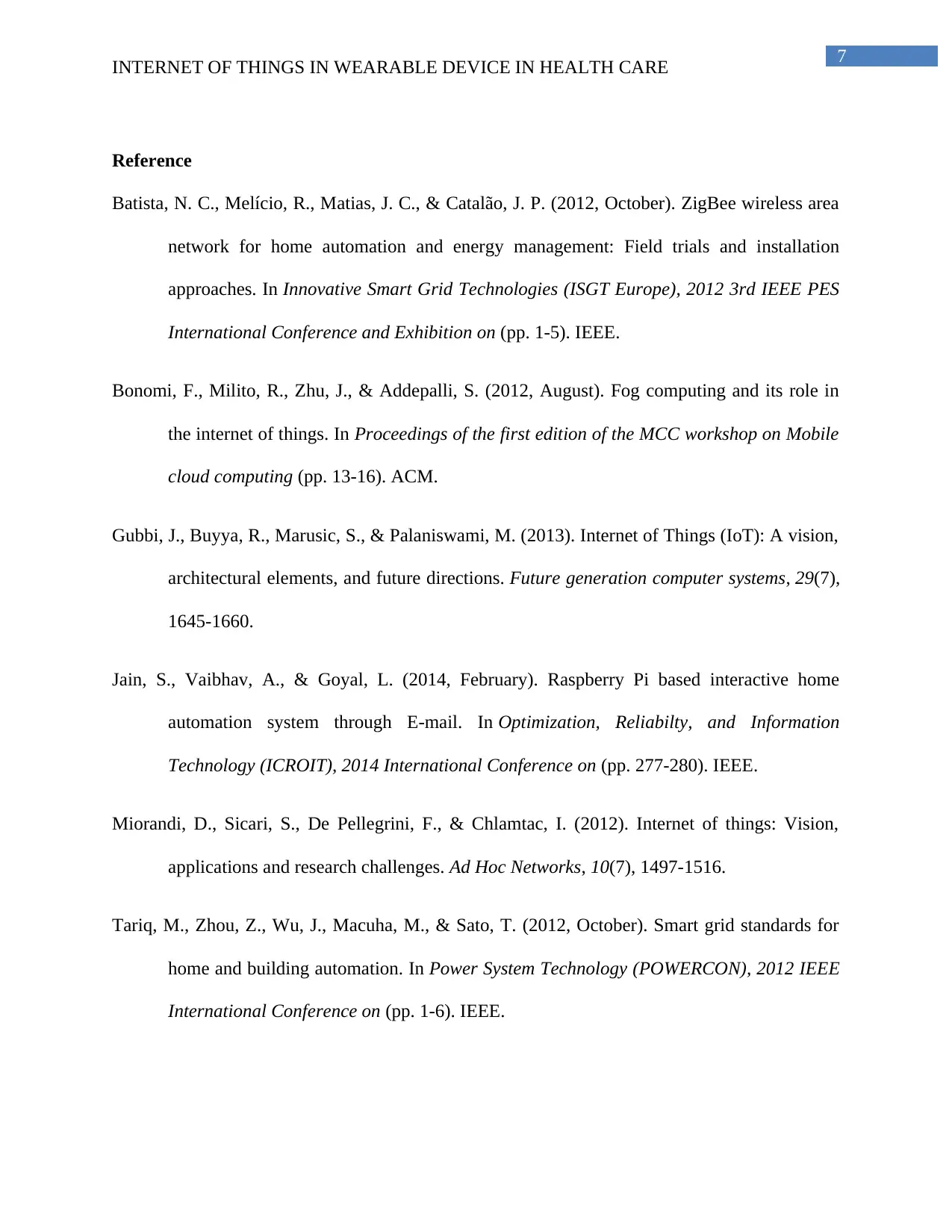
7
INTERNET OF THINGS IN WEARABLE DEVICE IN HEALTH CARE
Reference
Batista, N. C., Melício, R., Matias, J. C., & Catalão, J. P. (2012, October). ZigBee wireless area
network for home automation and energy management: Field trials and installation
approaches. In Innovative Smart Grid Technologies (ISGT Europe), 2012 3rd IEEE PES
International Conference and Exhibition on (pp. 1-5). IEEE.
Bonomi, F., Milito, R., Zhu, J., & Addepalli, S. (2012, August). Fog computing and its role in
the internet of things. In Proceedings of the first edition of the MCC workshop on Mobile
cloud computing (pp. 13-16). ACM.
Gubbi, J., Buyya, R., Marusic, S., & Palaniswami, M. (2013). Internet of Things (IoT): A vision,
architectural elements, and future directions. Future generation computer systems, 29(7),
1645-1660.
Jain, S., Vaibhav, A., & Goyal, L. (2014, February). Raspberry Pi based interactive home
automation system through E-mail. In Optimization, Reliabilty, and Information
Technology (ICROIT), 2014 International Conference on (pp. 277-280). IEEE.
Miorandi, D., Sicari, S., De Pellegrini, F., & Chlamtac, I. (2012). Internet of things: Vision,
applications and research challenges. Ad Hoc Networks, 10(7), 1497-1516.
Tariq, M., Zhou, Z., Wu, J., Macuha, M., & Sato, T. (2012, October). Smart grid standards for
home and building automation. In Power System Technology (POWERCON), 2012 IEEE
International Conference on (pp. 1-6). IEEE.
INTERNET OF THINGS IN WEARABLE DEVICE IN HEALTH CARE
Reference
Batista, N. C., Melício, R., Matias, J. C., & Catalão, J. P. (2012, October). ZigBee wireless area
network for home automation and energy management: Field trials and installation
approaches. In Innovative Smart Grid Technologies (ISGT Europe), 2012 3rd IEEE PES
International Conference and Exhibition on (pp. 1-5). IEEE.
Bonomi, F., Milito, R., Zhu, J., & Addepalli, S. (2012, August). Fog computing and its role in
the internet of things. In Proceedings of the first edition of the MCC workshop on Mobile
cloud computing (pp. 13-16). ACM.
Gubbi, J., Buyya, R., Marusic, S., & Palaniswami, M. (2013). Internet of Things (IoT): A vision,
architectural elements, and future directions. Future generation computer systems, 29(7),
1645-1660.
Jain, S., Vaibhav, A., & Goyal, L. (2014, February). Raspberry Pi based interactive home
automation system through E-mail. In Optimization, Reliabilty, and Information
Technology (ICROIT), 2014 International Conference on (pp. 277-280). IEEE.
Miorandi, D., Sicari, S., De Pellegrini, F., & Chlamtac, I. (2012). Internet of things: Vision,
applications and research challenges. Ad Hoc Networks, 10(7), 1497-1516.
Tariq, M., Zhou, Z., Wu, J., Macuha, M., & Sato, T. (2012, October). Smart grid standards for
home and building automation. In Power System Technology (POWERCON), 2012 IEEE
International Conference on (pp. 1-6). IEEE.
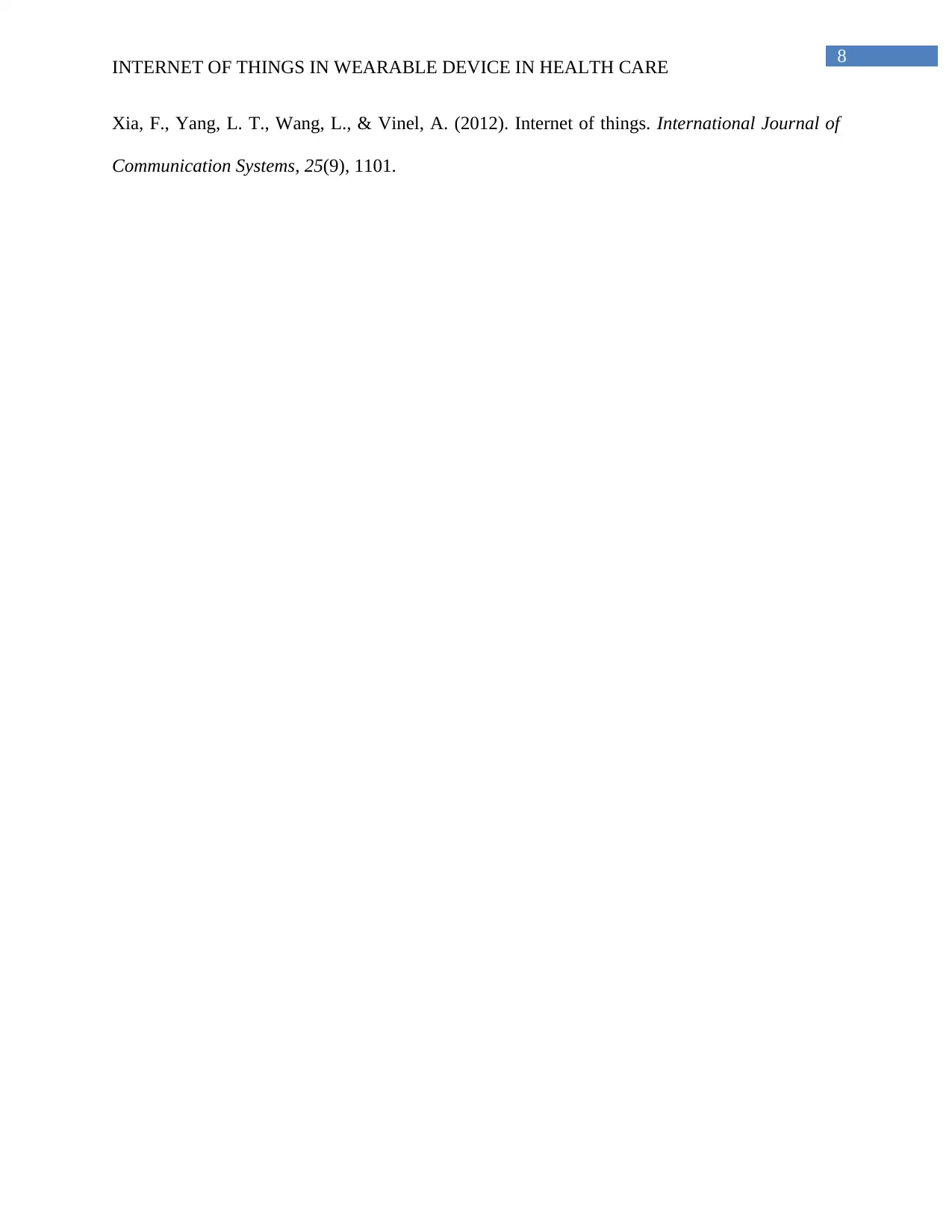
8
INTERNET OF THINGS IN WEARABLE DEVICE IN HEALTH CARE
Xia, F., Yang, L. T., Wang, L., & Vinel, A. (2012). Internet of things. International Journal of
Communication Systems, 25(9), 1101.
INTERNET OF THINGS IN WEARABLE DEVICE IN HEALTH CARE
Xia, F., Yang, L. T., Wang, L., & Vinel, A. (2012). Internet of things. International Journal of
Communication Systems, 25(9), 1101.
⊘ This is a preview!⊘
Do you want full access?
Subscribe today to unlock all pages.

Trusted by 1+ million students worldwide
1 out of 9
Related Documents
Your All-in-One AI-Powered Toolkit for Academic Success.
+13062052269
info@desklib.com
Available 24*7 on WhatsApp / Email
![[object Object]](/_next/static/media/star-bottom.7253800d.svg)
Unlock your academic potential
Copyright © 2020–2025 A2Z Services. All Rights Reserved. Developed and managed by ZUCOL.



